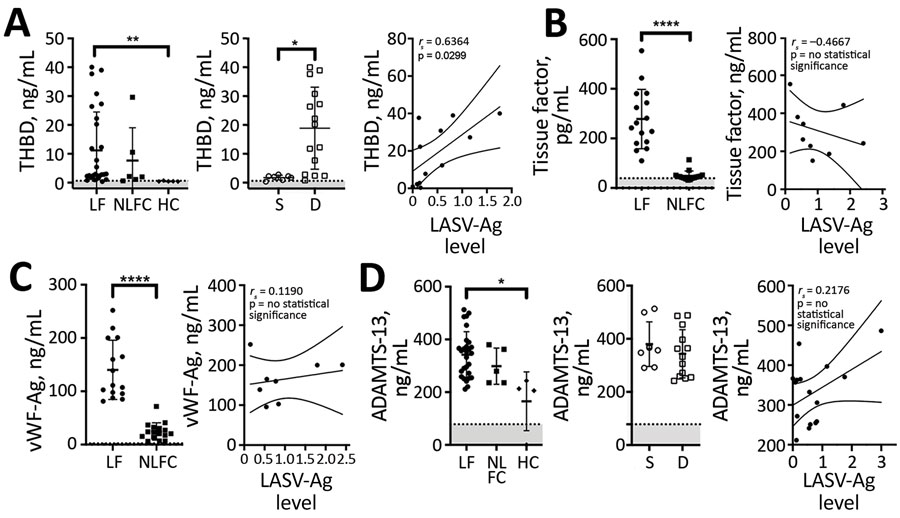Volume 26, Number 11—November 2020
Research
Endotheliopathy and Platelet Dysfunction as Hallmarks of Fatal Lassa Fever
Figure 2

Figure 2. Laboratory findings for coagulation markers for patients with acute LF, NLFCs, and HCs, Sierra Leone, 2015–2018. A) Soluble thrombomodulin is elevated in LF and predicts fatal outcomes (Kruskal-Wallis p = 0.0002 across all groups). Levels of soluble THBD were statistically significantly higher (**p = 0.0084) in acute LF cases (n = 28) than in HCs (n = 5); patients who died (n = 15) had higher levels of soluble THBD than those who survived (n = 7; *p = 0.0239); and we noted a positive correlation between soluble THBD and LASV-Ag levels (n = 12). B) Tissue factor was statistically significantly elevated (****p<0.0001) in acute fatal LF cases (n = 16) compared with NLFC (n = 16), but no statistically significant correlation was found between TF and LASV-Ag levels in LF patients. C) vWF Ag levels were statistically significantly elevated (****p<0.0001) in acute fatal LF patients (n = 15) compared with NLFC (n = 16), but no statistically significant correlation was found between vWF and LASV-Ag levels in LF patients. D) Plasma levels of ADAMTS-13 were statistically significantly different between groups (Kruskal-Wallis p = 0.0155). Levels of ADAMTS-13 were statistically significantly higher (*p = 0.0292) in patients with acute LF (n = 28) compared with HCs (n = 4). No differences were seen between those who died (n = 13) versus those who survived (n = 8), nor was a statistically significant correlation found between ADAMTS-13 and LASV-Ag in LF patients. Limits of detection are indicated by dashed lines and gray shading below. Error bars show SDs; horizontal lines indicate means. D, died; HC, healthy control; LF, Lassa fever; LASV-Ag, Lassa fever virus antigen; NLFC, non-LF febrile control; S, survived; THBD, thrombomodulin; vWF, von Willebrand factor; vWF-Ag, von Willebrand factor antigen.
1These authors contributed equally to this article.